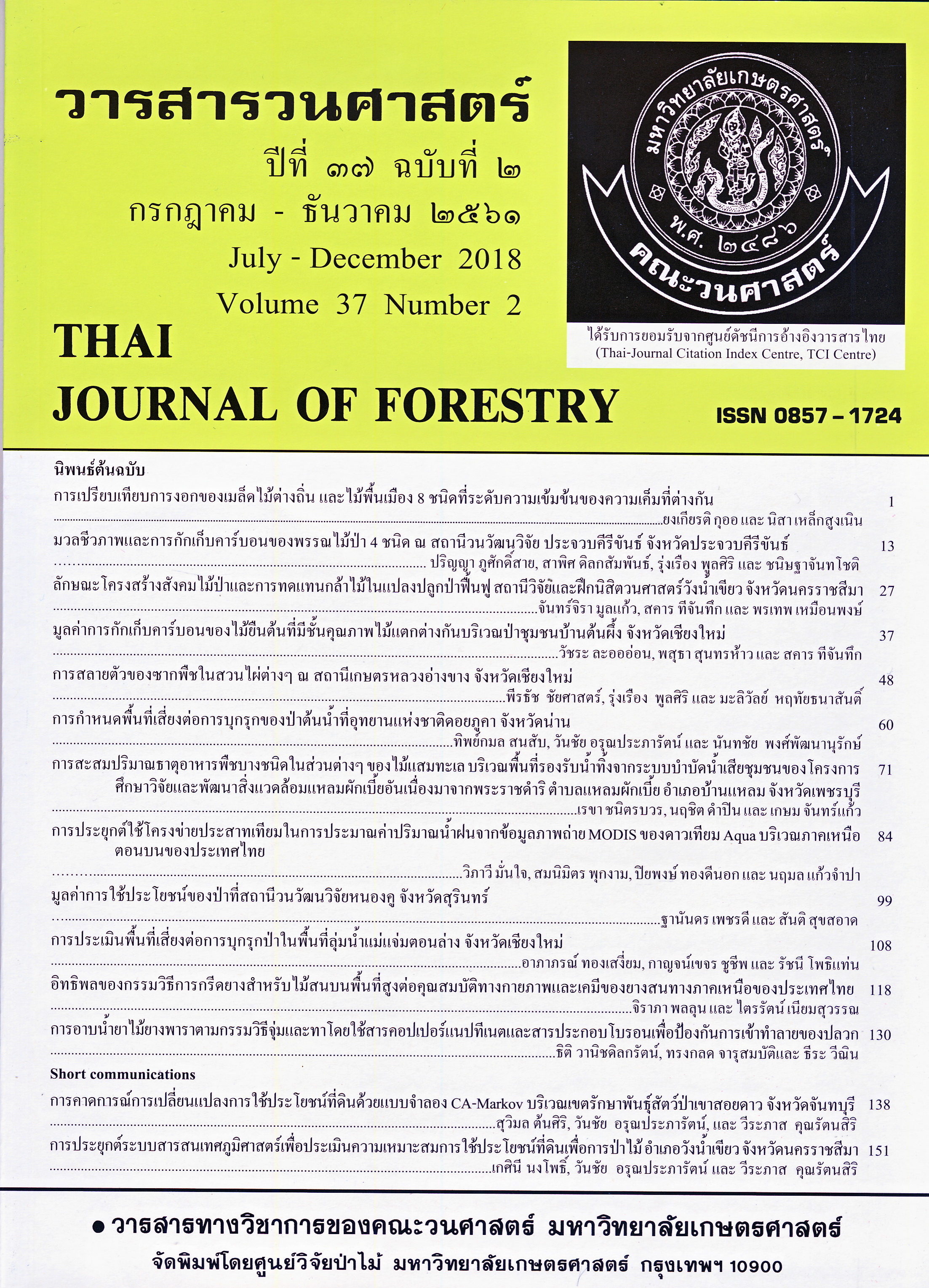มูลค่าการกักเก็บคาร์บอนของไม้ยืนต้นที่มีชั้นคุณภาพไม้แตกต่างกัน บริเวณป่าชุมชนบ้านต้นผึ้ง จังหวัดเชียงใหม่
Main Article Content
บทคัดย่อ
การศึกษามีวัตถุประสงค์เพื่อศึกษามูลค่าการกักเก็บคาร์บอนของไม้ยืนต้นที่มีชั้นคุณภาพ ไม้แตกต่างกัน รวมถึงศึกษาชนิดและความหนาแน่นของพรรณไม้ยืนต้นบริเวณป่าชุมชนบ้านต้นผึ้ง โดยใช้วิธีการสุ่มตัวอย่างแบบจำแนกชั้นภูมิตามความหนาแน่นเรือนยอดของหมู่ไม้ที่ปกคลุมทั้งหมด 3 ชั้นภูมิ วางแปลงตัวอย่างชั่วคราวขนาด 40 x 40 เมตร จำนวนทั้งหมด 9 แปลง โดยกระจาย 3 แปลงในแต่ละชั้นภูมิ ทำการเก็บข้อมูลชนิดไม้ยืนต้น ความโต ความสูงทั้งหมดและชั้นคุณภาพไม้ แล้วนำข้อมูลที่ได้วิเคราะห์หาความหนาแน่นของพรรณไม้ ปริมาณการกักเก็บคาร์บอน และมูลค่าการกักเก็บคาร์บอนตามราคาสมมุติและราคาตลาด
ผลการศึกษา พบว่า ภายในบริเวณป่าชุมชนบ้านต้นผึ้ง พบพรรณไม้ 22 ชนิด มีความหนาแน่น 199.58 ต้น/ไร่ มีปริมาณมวลชีวภาพทั้งหมด 6.70 ตัน/ไร่ ปริมาณการกักเก็บคาร์บอนทั้งหมด 3.15 ตันคาร์บอน/ไร่ ปริมาณการดูดซับก๊าซคาร์บอนไดออกไซด์ 11.55 ตันคาร์บอนไดออกไซด์/ไร่ โดยชั้นคุณภาพไม้ประเภท A, B, C มีปริมาณมวลชีวภาพทั้งหมด เท่ากับ 299.94, 2,282.55 และ 3,911.79 ตัน ตามลำดับ ปริมาณการกักเก็บคาร์บอนทั้งหมด เท่ากับ 140.97, 1,072.80 และ 1,838.54 ตันคาร์บอนตามลำดับ ปริมาณการดูดซับก๊าซคาร์บอนไดออกไซด์ทั้งหมด เท่ากับ 516.94, 3,933.95 และ 6,741.93ตันคาร์บอนไดออกไซด์ ตามลำดับ สำหรับมูลค่าการกักเก็บคาร์บอนในปีที่ 5 ที่ระดับอัตราดอกเบี้ย 6% และราคาซื้อขายคาร์บอน 500 บาท/ตันคาร์บอนไดออกไซด์ เท่ากับ 214, 1,627 และ 2,788 บาท/ไร่ตามลำดับ ราคาตลาด EUA ที่ราคาซื้อขายคาร์บอน 207 บาท/ตันคาร์บอนไดออกไซด์ เท่ากับ 89, 674และ 1,154 บาท/ไร่ ตามลำดับ และราคาตลาด CCA ที่ราคาซื้อขายคาร์บอน 481 บาท/ตันคาร์บอน-ไดออกไซด์ เท่ากับ 206, 1,565 และ 2,682 บาท/ไร่ ตามลำดับ
Downloads
Article Details
ข้าพเจ้าและผู้เขียนร่วม (ถ้ามี) ขอรับรองว่า ต้นฉบับที่เสนอมานี้ยังไม่เคยได้รับการตีพิมพ์และไม่ได้อยู่ในระหว่างกระบวนการพิจารณาตีพิมพ์ลงในวารสารหรือสิ่งตีพิมพ์อื่นใด ข้าพเจ้าและผู้เขียนร่วม (ถ้ามี) ยอมรับหลักเกณฑ์และเงื่อนไขการพิจารณาต้นฉบับ ทั้งยินยอมให้กองบรรณาธิการมีสิทธิ์พิจารณาและตรวจแก้ต้นฉบับได้ตามที่เห็นสมควร พร้อมนี้ขอมอบลิขสิทธิ์ผลงานที่ได้รับการตีพิมพ์ให้แก่วารสารวนศาสตร์ คณะวนศาสตร์ มหาวิทยาลัยเกษตรศาสตร์ กรณีมีการฟ้องร้องเรื่องการละเมิดลิขสิทธิ์เกี่ยวกับภาพ กราฟ ข้อความส่วนใดส่วนหนึ่ง หรือ ข้อคิดเห็นที่ปรากฏในผลงาน ให้เป็นความรับผิดชอบของข้าพเจ้าและผู้เขียนร่วม (ถ้ามี) แต่เพียงฝ่ายเดียว และหากข้าพเจ้าและผู้เขียนร่วม (ถ้ามี) ประสงค์ถอนบทความในระหว่างกระบวนการพิจารณาของทางวารสาร ข้าพเจ้าและผู้เขียนร่วม (ถ้ามี) ยินดีรับผิดชอบค่าใช้จ่ายทั้งหมดที่เกิดขึ้นในกระบวนการพิจารณาบทความนั้น”
เอกสารอ้างอิง
จุฬาลักษณ์ ขวัญเจริญศรี, กิตติ เอกอำพนและรุ่งเรือง พูลศิริ. 2556. การเติบโต มวลชีวภาพและการกักเก็บคาร์บอนในสบู่ดำ. วารสารวนศาสตร์ 32 (3): 1-11.
สถิตย์ วัชรกิตติ. 2525. การสำรวจทรัพยากรป่าไม้. ภาควิชาการจัดการป่าไม้ คณะวนศาสตร์มหาวิทยาลัยเกษตรศาสตร์, กรุงเทพฯ.
องค์การบริหารจัดการก๊าซเรือนกระจก (องค์การมหาชน). 2560. ตลาดคาร์บอนรายสัปดาห์ 27 กุมภาพันธ์ - 3 มีนาคม 2560. แหล่งที่มา: carbonmarket.tgo.or.th/weekly/list/list.pnc, 3 มีนาคม 2560.
Hoamuangkaew, W. 2010. Forestry Economics. Forest Management, Facultry of Forestry, Kasetsart University, Bangkok.
Intergovernmental Panel on Climate Change. 2006. IPCC Guidelines for National Greenhouse Gas Inventories. InternationalPanel on Climate Change. IGES, Japan.
Ogawa, H., K. Yoda, K. Ogino and T. Kira. 1965. Comparative ecological studies on three main types of forest vegetation in Thailand. II. Plant Biomass. Nature and Life in Southeast Asia 4: 13-80.
Sunthornhao, P., W. Hoamuangkaew, N.Charadratanawong and S. Putiwanich. 2012. Community Forest Management Assessment under “Kon Rak Pa Pa Rak Chum Chon Project” Implementation by Royal Forest Department and Ratchaburi Electricity Generating Holding Public Company Limited, Phase III, 2012. Forestry Research Center, Faculty of Forestry, Kasetsart University, Bangkok. Thailand.
Thinchant, S. 2003. Valuation of the Using Value of Forest Resources in Prasae-Pangrad Mangrove Forest, Rayong Province. M.S. Thesis, Kasetsart University.


